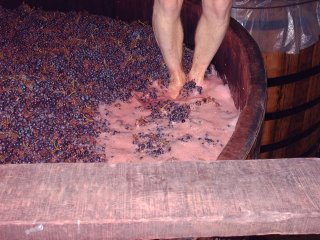
Glenmorangie are quite unique in the fact that the Tarlogie Springs are bubbled up through layers of limestone and chalk, which are somewhat out of place in the Granitic hills and mountains of Scotland. As a result the water is quite "hard" - ie has high levels of dissolved minerals and salts especially Calcium salts. So they guard the springs quite jealously. The water was cristal clear and when we looked we could see the water bubbling up through the sandy soil at the bottom of the spring. After walking around the spring we headed back to the distillery for a guided tour of the operation. Starting at the old malting house where in days gone by they would have malted the barley themselves, these days the barley comes from a central maltings who toast the grains to a specification laid down by Glenmorangie. The barley passes through the mills to grind it into a course flour before being added to the mash tun. Here it is soaked in 60degree water to break open the starch cells and allow enzymes to start the process of breaking down the long chain starches into short molecule sugars which the yeasts can then convert to alcohol. Once all the sugars have been extracted the solution is then passed into the washbacks where the yeast is added at nature takes its course. They aim for a quick ferment to convert all the sugar into alcohol. Once this is done the result is called the low wines, and is approximately 9 % abv. It then goes into a low wines reciever before being pumped into the first still for the first distillation. The stills at Glenmorangie are amongst the highest in Scotland and this allows the purest alcohols to reach the top where they travel down into the condensers to be collected for the second distillation. The second set of stills are slightly smaller than the first ones and again here the aim is to purify the spirit and remove the harmful alcohols like methanol. So the foreshots are the first cut, and they get re-cycled back into the process to be endlessly refined. The middle cut is the sweetest and purest ethanol and it is this that will end its days maturing in an oak cask to be become Glenmorangie. The feints or end cut is the roughest and again it is re-cycled back to be redistilled.
We were then taken round to see the place where the spirit is filled into oak casks where it must mature for a minimum of three years before it can legally be called whisky. It is in the selection of the casks that for many years Glenmorangie has led the market. Dr Bill then took us into Warehouse number three to show us the Artisan casks.

Specially selected from trees grown in the Ozark mountains of America these casks are quite special. The exceptionally slow growth of the trees means that the rings are quite tightly packed and so the wood is quite dense and tightly grained. This interacts with the spirit in a way that I cant quite understand, but it seems to have a profound difference to the "standard" Glenmorangie. Must be pixie magic! Anyway as you can see from the picture Bill gets quite excited about these casks. While in the warehouse we got the opportunity to taste the differences between first fill casks and second fills. The first fills have a much richer, more caramelised character to them, with toasty coconut flavours being dominant. The second fills were much lighter in colour with a lighter nose, more minty floral with hints of lighter nuts - hazel, cobnuts. After a bit of a nosey in there and a cracking atmospheric photo it was time to return to the offices for our tutored tasting.






No comments:
Post a Comment